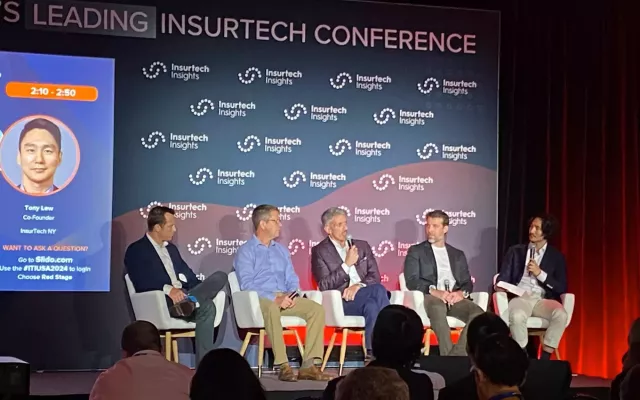It was sort of fitting that sleep neuroscientist Dr. Els van der Helm had two keynote sessions at Insurtech Insights, held in the city that never does this week. With the industry facing challenges that span increased loss ratios and expenses, to decreased funding for insurtechs, many attendees have likely lost some sleep over the past year.
How to deal with and embrace the many changes facing the industry was a theme threaded through educational sessions and conversations for the 5,000+ insurance pros from insurtechs, carriers, agents, brokers, MGAs and technology partners gathered at the Javits Center in New York City. One of the panelists in a session on attracting new talent to the insurance industry put it quite well in saying that “willingness to change” would become a core competency in the business.
How are insurance industry leaders embracing that call? Our team was there to hear and participate in these conversations, and has these takeaways to share with those in the industry.
The insurance industry is one of the first-movers on generative AI and AI technologies.
For an industry typically viewed as “slow adopters of technology, insurers across all lines of business are actively investing in GenAI,” according to EY. Generative AI in underwriting, claims management, talent development, and much more was the focus of more than 30 sessions. Some of the actual and potential use cases talked about at the show included:
- Connecting pricing metrics to drive more value in underwriting, such as finding correlations between the purchasing of life insurance and being a good auto insurance customer.
- Pointing generative AI at proprietary data stores – whether a data warehouse or data lake – and giving users autonomy to ask pointed questions, such as where customers are dropping off in different flows.
- Interrogating and summarizing data across hundreds of documents to help with decision-making in underwriting.
Panelists and audience members brought up really good questions on the roadblocks to realizing GenAI’s value, spanning:
- How to improve current data quality and governance processes to really unlock the technology’s potential.
- How to best balance innovation and the need for a human in the customer experience.
- The impact on talent development if younger workers no longer gain critical building block skills because many tasks are automated.
Where is this all going? The winners, so to speak, will be the ones who can connect the data no one else has to generate knowledge. AI will impact the tasks we do today, and humans will create new jobs for the tasks of the future, Aditi Javeri Gokale of Northwestern Mutual and Naveen Agaral of NavDots told the audience in their session, “Beyond Tomorrow - Charting the AI/Human Frontier.”
As new tech comes into play, the leaders are doubling down on modernizing legacy infrastructure and ensuring data quality.
Many panelists pointed to the importance of modernizing legacy systems to move at the speed that change demands. CIO Jim MacMillan of Vantage Risk Companies put it very well: if you build the foundation right, we’re going to be the most innovative.
In fact, one of the biggest barriers to AI adoption is legacy infrastructure, according to EY, with 57% of 200 senior insurance decision-makers it surveyed saying integration with legacy systems is a barrier when implementing Generative AI.
EPAM data tells a similar story, with 45% of respondents to a survey saying outdated technological infrastructure is the primary obstacle to adopting digital tools and innovative work practices. Systems integration, particularly with underwriting systems, will be a critical success factor to realizing AI value, a key takeaway in the panel discussion on “Tomorrow’s Underwriter: The Impact of GenAI in Revolutionizing Insurance.”
Customer-centricity is driving tech investments in insurance.
Should automation aimed at boosting internal efficiencies always be the first driver in technology investments? Maybe not. Asked in a panel discussion how to prioritize, the advice of Bill Martin, President and CEO of Plymouth Rock Home Assurance, shows a customer-first strategy in action. They prioritize technology that attracts, retains and offers more value to the customer and to the transaction. And that pays dividends when it comes to employee engagement. Employees get a lot more excited about technology that offers a good customer experience, “than an RPA to fill out a form for us.”
Innovating on the customer experience – whether that customer is the policyholder or the partner in the distribution channel – will be critical as Generative AI sort of begins to democratize efficiency. Cameron Torstenson, EVP, Chief Marketing Officer at EMC National Life Company put it well: the technology will create an efficiency free-for-all. There is not a big long-term competitive advantage for focusing on being the most efficient.
As there are very few customer touchpoints in insurance, it is very important to get them 100% right. One overlooked touchpoint is payment. Insurance customers expect transactions to be as quick and easy as shopping with an online merchant, according to PwC. Industry leaders are thinking about payments as part of the customer experience, Flywire SVP Greg Leven told the audience gathered for “Customer Centricity and UX: The Keys to Success In Insurance Distribution.”
“Payments, to us, should be like it is in Uber. It just happens on the back of a great process,” he said.
When the payment is embedded, the customer has a great experience in the policy UX. And that deepens trust – the most important currency in the industry.
“At the core of the business, we are selling trust,” he said. “And that has always made us customer-centric.”
3 things heard on the show floor
- Coolest insurance title: Director of Underwriting Innovation
- Most heard term other than GenAI: Parametric insurance. Check out what baoba is doing in terms of real-time protection in the form of payments or airport lounge access for flight delays and cancellations.
- New AI term. Spatial AI, which imparts a robot with depth perception, to, say, pick a banana out of a fruit basket.

